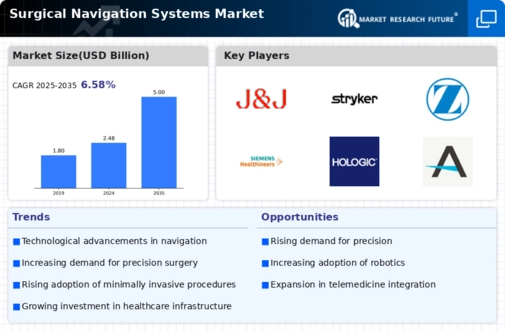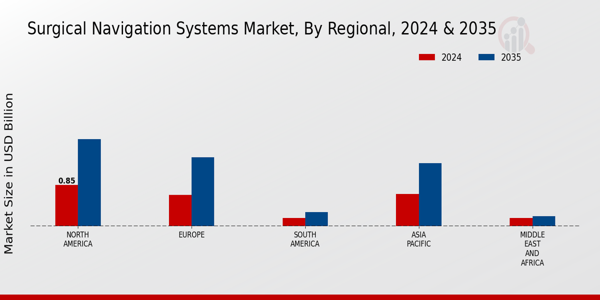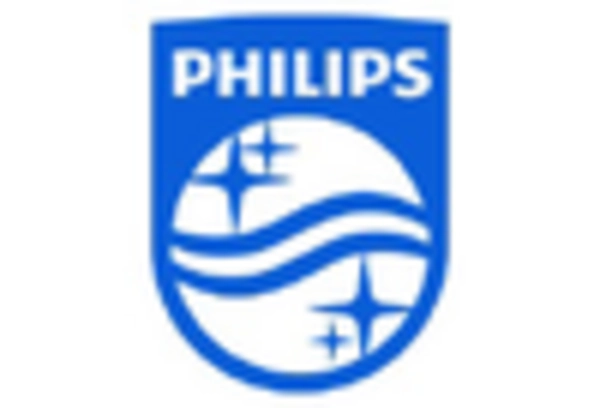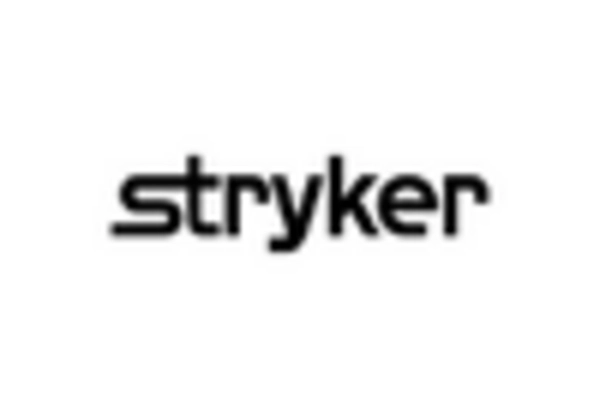-
FACTOR ANALYSIS
-
\r\n\r\n\r\nValue chain Analysis
-
\r\n\r\n\r\nPorter's
-
Five Forces Analysis
-
\r\n\r\n\r\nBargaining Power of Suppliers
-
\r\n\r\n\r\nBargaining
-
Power of Buyers
-
\r\n\r\n\r\nThreat of New Entrants
-
\r\n\r\n\r\nThreat
-
of Substitutes
-
\r\n\r\n\r\nIntensity of Rivalry
-
\r\n\r\n\r\n\r\n\r\nCOVID-19
-
Impact Analysis
-
\r\n\r\n\r\nMarket Impact Analysis
-
\r\n\r\n\r\nRegional
-
Impact
-
\r\n\r\n\r\nOpportunity and Threat Analysis
-
\r\n\r\n\r\n\r\n\r\n\r\n\r\n
-
\r\n
-
\r\n\r\n\r\nSurgical
-
Navigation Systems Market, BY Technology (USD Billion)
-
\r\n\r\n\r\nOptical
-
Navigation Systems
-
\r\n\r\n\r\nElectromagnetic Navigation Systems
-
\r\n\r\n\r\nHybrid
-
Navigation Systems
-
\r\n\r\n\r\nRobotic-Assisted Navigation Systems
-
\r\n\r\n\r\n\r\n\r\nSurgical
-
Navigation Systems Market, BY Application (USD Billion)
-
\r\n\r\n\r\nOrthopedics
-
\r\n\r\n\r\nNeurosurgery
-
\r\n\r\n\r\nENT
-
Surgery
-
\r\n\r\n\r\nSpinal Surgery
-
\r\n\r\n\r\nCardiac
-
Surgery
-
\r\n\r\n\r\n\r\n\r\nSurgical Navigation
-
Systems Market, BY End Use (USD Billion)
-
\r\n\r\n\r\nHospitals
-
\r\n\r\n\r\nAmbulatory
-
Surgical Centers
-
\r\n\r\n\r\nResearch Institutions
-
\r\n\r\n\r\n\r\n\r\nSurgical
-
Navigation Systems Market, BY Component (USD Billion)
-
\r\n\r\n\r\nHardware
-
\r\n\r\n\r\nSoftware
-
\r\n\r\n\r\nServices
-
\r\n\r\n\r\n\r\n\r\nSurgical
-
Navigation Systems Market, BY Regional (USD Billion)
-
\r\n\r\n\r\nNorth
-
America
-
\r\n\r\n\r\nUS
-
\r\n\r\n\r\nCanada
-
\r\n\r\n\r\n\r\n\r\nEurope
-
\r\n\r\n\r\nGermany
-
\r\n\r\n\r\nUK
-
\r\n\r\n\r\nFrance
-
\r\n\r\n\r\nRussia
-
\r\n\r\n\r\nItaly
-
\r\n\r\n\r\nSpain
-
\r\n\r\n\r\nRest
-
of Europe
-
\r\n\r\n\r\n\r\n\r\nAPAC
-
\r\n\r\n\r\nChina
-
\r\n\r\n\r\nIndia
-
\r\n\r\n\r\nJapan
-
\r\n\r\n\r\nSouth
-
Korea
-
\r\n\r\n\r\nMalaysia
-
\r\n\r\n\r\nThailand
-
\r\n\r\n\r\nIndonesia
-
\r\n\r\n\r\nRest
-
of APAC
-
\r\n\r\n\r\n\r\n\r\nSouth America
-
\r\n\r\n\r\nBrazil
-
\r\n\r\n\r\nMexico
-
\r\n\r\n\r\nArgentina
-
\r\n\r\n\r\nRest
-
of South America
-
\r\n\r\n\r\n\r\n\r\nMEA
-
\r\n\r\n\r\nGCC
-
Countries
-
\r\n\r\n\r\nSouth Africa
-
\r\n\r\n\r\nRest
-
of MEA
-
\r\n\r\n\r\n\r\n\r\n\r\n\r\n
-
\r\n
-
\r\n\r\n\r\nCompetitive
-
Landscape
-
\r\n\r\n\r\nOverview
-
\r\n\r\n\r\nCompetitive
-
Analysis
-
\r\n\r\n\r\nMarket share Analysis
-
\r\n\r\n\r\nMajor
-
Growth Strategy in the Surgical Navigation Systems Market
-
\r\n\r\n\r\nCompetitive
-
Benchmarking
-
\r\n\r\n\r\nLeading Players in Terms of Number of Developments
-
in the Surgical Navigation Systems Market
-
\r\n\r\n\r\nKey developments
-
and growth strategies
-
\r\n\r\n\r\nNew Product Launch/Service Deployment
-
\r\n\r\n\r\nMerger
-
& Acquisitions
-
\r\n\r\n\r\nJoint Ventures
-
\r\n\r\n\r\n\r\n\r\nMajor
-
Players Financial Matrix
-
\r\n\r\n\r\nSales and Operating Income
-
\r\n\r\n\r\nMajor
-
Players R&D Expenditure. 2023
-
\r\n\r\n\r\n\r\n\r\n\r\n\r\nCompany
-
Profiles
-
\r\n\r\n\r\nZimmer Biomet
-
\r\n\r\n\r\nFinancial
-
Overview
-
\r\n\r\n\r\nProducts Offered
-
\r\n\r\n\r\nKey
-
Developments
-
\r\n\r\n\r\nSWOT Analysis
-
\r\n\r\n\r\nKey
-
Strategies
-
\r\n\r\n\r\n\r\n\r\nSmith and Nephew
-
\r\n\r\n\r\nFinancial
-
Overview
-
\r\n\r\n\r\nProducts Offered
-
\r\n\r\n\r\nKey
-
Developments
-
\r\n\r\n\r\nSWOT Analysis
-
\r\n\r\n\r\nKey
-
Strategies
-
\r\n\r\n\r\n\r\n\r\nDePuy Synthes
-
\r\n\r\n\r\nFinancial
-
Overview
-
\r\n\r\n\r\nProducts Offered
-
\r\n\r\n\r\nKey
-
Developments
-
\r\n\r\n\r\nSWOT Analysis
-
\r\n\r\n\r\nKey
-
Strategies
-
\r\n\r\n\r\n\r\n\r\nLeica Biosystems
-
\r\n\r\n\r\nFinancial
-
Overview
-
\r\n\r\n\r\nProducts Offered
-
\r\n\r\n\r\nKey
-
Developments
-
\r\n\r\n\r\nSWOT Analysis
-
\r\n\r\n\r\nKey
-
Strategies
-
\r\n\r\n\r\n\r\n\r\nVarian Medical Systems
-
\r\n\r\n\r\nFinancial
-
Overview
-
\r\n\r\n\r\nProducts Offered
-
\r\n\r\n\r\nKey
-
Developments
-
\r\n\r\n\r\nSWOT Analysis
-
\r\n\r\n\r\nKey
-
Strategies
-
\r\n\r\n\r\n\r\n\r\nPhilips
-
\r\n\r\n\r\nFinancial
-
Overview
-
\r\n\r\n\r\nProducts Offered
-
\r\n\r\n\r\nKey
-
Developments
-
\r\n\r\n\r\nSWOT Analysis
-
\r\n\r\n\r\nKey
-
Strategies
-
\r\n\r\n\r\n\r\n\r\nIntuitive Surgical
-
\r\n\r\n\r\nFinancial
-
Overview
-
\r\n\r\n\r\nProducts Offered
-
\r\n\r\n\r\nKey
-
Developments
-
\r\n\r\n\r\nSWOT Analysis
-
\r\n\r\n\r\nKey
-
Strategies
-
\r\n\r\n\r\n\r\n\r\nGE Healthcare
-
\r\n\r\n\r\nFinancial
-
Overview
-
\r\n\r\n\r\nProducts Offered
-
\r\n\r\n\r\nKey
-
Developments
-
\r\n\r\n\r\nSWOT Analysis
-
\r\n\r\n\r\nKey
-
Strategies
-
\r\n\r\n\r\n\r\n\r\nNavidea Biopharmaceuticals
-
\r\n\r\n\r\nFinancial
-
Overview
-
\r\n\r\n\r\nProducts Offered
-
\r\n\r\n\r\nKey
-
Developments
-
\r\n\r\n\r\nSWOT Analysis
-
\r\n\r\n\r\nKey
-
Strategies
-
\r\n\r\n\r\n\r\n\r\nStryker
-
\r\n\r\n\r\nFinancial
-
Overview
-
\r\n\r\n\r\nProducts Offered
-
\r\n\r\n\r\nKey
-
Developments
-
\r\n\r\n\r\nSWOT Analysis
-
\r\n\r\n\r\nKey
-
Strategies
-
\r\n\r\n\r\n\r\n\r\nAccuray
-
\r\n\r\n\r\nFinancial
-
Overview
-
\r\n\r\n\r\nProducts Offered
-
\r\n\r\n\r\nKey
-
Developments
-
\r\n\r\n\r\nSWOT Analysis
-
\r\n\r\n\r\nKey
-
Strategies
-
\r\n\r\n\r\n\r\n\r\nMedtronic
-
\r\n\r\n\r\nFinancial
-
Overview
-
\r\n\r\n\r\nProducts Offered
-
\r\n\r\n\r\nKey
-
Developments
-
\r\n\r\n\r\nSWOT Analysis
-
\r\n\r\n\r\nKey
-
Strategies
-
\r\n\r\n\r\n\r\n\r\nBrainlab
-
\r\n\r\n\r\nFinancial
-
Overview
-
\r\n\r\n\r\nProducts Offered
-
\r\n\r\n\r\nKey
-
Developments
-
\r\n\r\n\r\nSWOT Analysis
-
\r\n\r\n\r\nKey
-
Strategies
-
\r\n\r\n\r\n\r\n\r\nOlympus Corporation
-
\r\n\r\n\r\nFinancial
-
Overview
-
\r\n\r\n\r\nProducts Offered
-
\r\n\r\n\r\nKey
-
Developments
-
\r\n\r\n\r\nSWOT Analysis
-
\r\n\r\n\r\nKey
-
Strategies
-
\r\n\r\n\r\n\r\n\r\nSiemens Healthineers
-
\r\n\r\n\r\nFinancial
-
Overview
-
\r\n\r\n\r\nProducts Offered
-
\r\n\r\n\r\nKey
-
Developments
-
\r\n\r\n\r\nSWOT Analysis
-
\r\n\r\n\r\nKey
-
Strategies
-
\r\n\r\n\r\n\r\n\r\n\r\n\r\nAppendix
-
\r\n\r\n\r\nReferences
-
\r\n\r\n\r\nRelated
-
Reports
-
\r\n\r\n\r\n\r\n\r\nLIST Of tables
-
\r\n
-
\r\n\r\n\r\nLIST
-
OF ASSUMPTIONS
-
\r\n\r\n\r\nNorth America Surgical Navigation Systems
-
Market SIZE ESTIMATES & FORECAST, BY TECHNOLOGY, 2019-2035 (USD Billions)
-
\r\n\r\n\r\nNorth
-
America Surgical Navigation Systems Market SIZE ESTIMATES & FORECAST, BY APPLICATION,
-
\r\n\r\n\r\nNorth America Surgical Navigation
-
Systems Market SIZE ESTIMATES & FORECAST, BY END USE, 2019-2035 (USD Billions)
-
\r\n\r\n\r\nNorth
-
America Surgical Navigation Systems Market SIZE ESTIMATES & FORECAST, BY COMPONENT,
-
\r\n\r\n\r\nNorth America Surgical Navigation
-
Systems Market SIZE ESTIMATES & FORECAST, BY REGIONAL, 2019-2035 (USD Billions)
-
\r\n\r\n\r\nUS
-
Surgical Navigation Systems Market SIZE ESTIMATES & FORECAST, BY TECHNOLOGY,
-
\r\n\r\n\r\nUS Surgical Navigation Systems
-
Market SIZE ESTIMATES & FORECAST, BY APPLICATION, 2019-2035 (USD Billions)
-
\r\n\r\n\r\nUS
-
Surgical Navigation Systems Market SIZE ESTIMATES & FORECAST, BY END USE, 2019-2035
-
(USD Billions)
-
\r\n\r\n\r\nUS Surgical Navigation Systems Market
-
SIZE ESTIMATES & FORECAST, BY COMPONENT, 2019-2035 (USD Billions)
-
\r\n\r\n\r\nUS
-
Surgical Navigation Systems Market SIZE ESTIMATES & FORECAST, BY REGIONAL, 2019-2035
-
(USD Billions)
-
\r\n\r\n\r\nCanada Surgical Navigation Systems Market
-
SIZE ESTIMATES & FORECAST, BY TECHNOLOGY, 2019-2035 (USD Billions)
-
\r\n\r\n\r\nCanada
-
Surgical Navigation Systems Market SIZE ESTIMATES & FORECAST, BY APPLICATION,
-
\r\n\r\n\r\nCanada Surgical Navigation Systems
-
Market SIZE ESTIMATES & FORECAST, BY END USE, 2019-2035 (USD Billions)
-
\r\n\r\n\r\nCanada
-
Surgical Navigation Systems Market SIZE ESTIMATES & FORECAST, BY COMPONENT,
-
\r\n\r\n\r\nCanada Surgical Navigation Systems
-
Market SIZE ESTIMATES & FORECAST, BY REGIONAL, 2019-2035 (USD Billions)
-
\r\n\r\n\r\nEurope
-
Surgical Navigation Systems Market SIZE ESTIMATES & FORECAST, BY TECHNOLOGY,
-
\r\n\r\n\r\nEurope Surgical Navigation Systems
-
Market SIZE ESTIMATES & FORECAST, BY APPLICATION, 2019-2035 (USD Billions)
-
\r\n\r\n\r\nEurope
-
Surgical Navigation Systems Market SIZE ESTIMATES & FORECAST, BY END USE, 2019-2035
-
(USD Billions)
-
\r\n\r\n\r\nEurope Surgical Navigation Systems Market
-
SIZE ESTIMATES & FORECAST, BY COMPONENT, 2019-2035 (USD Billions)
-
\r\n\r\n\r\nEurope
-
Surgical Navigation Systems Market SIZE ESTIMATES & FORECAST, BY REGIONAL, 2019-2035
-
(USD Billions)
-
\r\n\r\n\r\nGermany Surgical Navigation Systems Market
-
SIZE ESTIMATES & FORECAST, BY TECHNOLOGY, 2019-2035 (USD Billions)
-
\r\n\r\n\r\nGermany
-
Surgical Navigation Systems Market SIZE ESTIMATES & FORECAST, BY APPLICATION,
-
\r\n\r\n\r\nGermany Surgical Navigation
-
Systems Market SIZE ESTIMATES & FORECAST, BY END USE, 2019-2035 (USD Billions)
-
\r\n\r\n\r\nGermany
-
Surgical Navigation Systems Market SIZE ESTIMATES & FORECAST, BY COMPONENT,
-
\r\n\r\n\r\nGermany Surgical Navigation
-
Systems Market SIZE ESTIMATES & FORECAST, BY REGIONAL, 2019-2035 (USD Billions)
-
\r\n\r\n\r\nUK
-
Surgical Navigation Systems Market SIZE ESTIMATES & FORECAST, BY TECHNOLOGY,
-
\r\n\r\n\r\nUK Surgical Navigation Systems
-
Market SIZE ESTIMATES & FORECAST, BY APPLICATION, 2019-2035 (USD Billions)
-
\r\n\r\n\r\nUK
-
Surgical Navigation Systems Market SIZE ESTIMATES & FORECAST, BY END USE, 2019-2035
-
(USD Billions)
-
\r\n\r\n\r\nUK Surgical Navigation Systems Market
-
SIZE ESTIMATES & FORECAST, BY COMPONENT, 2019-2035 (USD Billions)
-
\r\n\r\n\r\nUK
-
Surgical Navigation Systems Market SIZE ESTIMATES & FORECAST, BY REGIONAL, 2019-2035
-
(USD Billions)
-
\r\n\r\n\r\nFrance Surgical Navigation Systems Market
-
SIZE ESTIMATES & FORECAST, BY TECHNOLOGY, 2019-2035 (USD Billions)
-
\r\n\r\n\r\nFrance
-
Surgical Navigation Systems Market SIZE ESTIMATES & FORECAST, BY APPLICATION,
-
\r\n\r\n\r\nFrance Surgical Navigation Systems
-
Market SIZE ESTIMATES & FORECAST, BY END USE, 2019-2035 (USD Billions)
-
\r\n\r\n\r\nFrance
-
Surgical Navigation Systems Market SIZE ESTIMATES & FORECAST, BY COMPONENT,
-
\r\n\r\n\r\nFrance Surgical Navigation Systems
-
Market SIZE ESTIMATES & FORECAST, BY REGIONAL, 2019-2035 (USD Billions)
-
\r\n\r\n\r\nRussia
-
Surgical Navigation Systems Market SIZE ESTIMATES & FORECAST, BY TECHNOLOGY,
-
\r\n\r\n\r\nRussia Surgical Navigation Systems
-
Market SIZE ESTIMATES & FORECAST, BY APPLICATION, 2019-2035 (USD Billions)
-
\r\n\r\n\r\nRussia
-
Surgical Navigation Systems Market SIZE ESTIMATES & FORECAST, BY END USE, 2019-2035
-
(USD Billions)
-
\r\n\r\n\r\nRussia Surgical Navigation Systems Market
-
SIZE ESTIMATES & FORECAST, BY COMPONENT, 2019-2035 (USD Billions)
-
\r\n\r\n\r\nRussia
-
Surgical Navigation Systems Market SIZE ESTIMATES & FORECAST, BY REGIONAL, 2019-2035
-
(USD Billions)
-
\r\n\r\n\r\nItaly Surgical Navigation Systems Market
-
SIZE ESTIMATES & FORECAST, BY TECHNOLOGY, 2019-2035 (USD Billions)
-
\r\n\r\n\r\nItaly
-
Surgical Navigation Systems Market SIZE ESTIMATES & FORECAST, BY APPLICATION,
-
\r\n\r\n\r\nItaly Surgical Navigation Systems
-
Market SIZE ESTIMATES & FORECAST, BY END USE, 2019-2035 (USD Billions)
-
\r\n\r\n\r\nItaly
-
Surgical Navigation Systems Market SIZE ESTIMATES & FORECAST, BY COMPONENT,
-
\r\n\r\n\r\nItaly Surgical Navigation Systems
-
Market SIZE ESTIMATES & FORECAST, BY REGIONAL, 2019-2035 (USD Billions)
-
\r\n\r\n\r\nSpain
-
Surgical Navigation Systems Market SIZE ESTIMATES & FORECAST, BY TECHNOLOGY,
-
\r\n\r\n\r\nSpain Surgical Navigation Systems
-
Market SIZE ESTIMATES & FORECAST, BY APPLICATION, 2019-2035 (USD Billions)
-
\r\n\r\n\r\nSpain
-
Surgical Navigation Systems Market SIZE ESTIMATES & FORECAST, BY END USE, 2019-2035
-
(USD Billions)
-
\r\n\r\n\r\nSpain Surgical Navigation Systems Market
-
SIZE ESTIMATES & FORECAST, BY COMPONENT, 2019-2035 (USD Billions)
-
\r\n\r\n\r\nSpain
-
Surgical Navigation Systems Market SIZE ESTIMATES & FORECAST, BY REGIONAL, 2019-2035
-
(USD Billions)
-
\r\n\r\n\r\nRest of Europe Surgical Navigation Systems
-
Market SIZE ESTIMATES & FORECAST, BY TECHNOLOGY, 2019-2035 (USD Billions)
-
\r\n\r\n\r\nRest
-
of Europe Surgical Navigation Systems Market SIZE ESTIMATES & FORECAST, BY APPLICATION,
-
\r\n\r\n\r\nRest of Europe Surgical Navigation
-
Systems Market SIZE ESTIMATES & FORECAST, BY END USE, 2019-2035 (USD Billions)
-
\r\n\r\n\r\nRest
-
of Europe Surgical Navigation Systems Market SIZE ESTIMATES & FORECAST, BY COMPONENT,
-
\r\n\r\n\r\nRest of Europe Surgical Navigation
-
Systems Market SIZE ESTIMATES & FORECAST, BY REGIONAL, 2019-2035 (USD Billions)
-
\r\n\r\n\r\nAPAC
-
Surgical Navigation Systems Market SIZE ESTIMATES & FORECAST, BY TECHNOLOGY,
-
\r\n\r\n\r\nAPAC Surgical Navigation Systems
-
Market SIZE ESTIMATES & FORECAST, BY APPLICATION, 2019-2035 (USD Billions)
-
\r\n\r\n\r\nAPAC
-
Surgical Navigation Systems Market SIZE ESTIMATES & FORECAST, BY END USE, 2019-2035
-
(USD Billions)
-
\r\n\r\n\r\nAPAC Surgical Navigation Systems Market
-
SIZE ESTIMATES & FORECAST, BY COMPONENT, 2019-2035 (USD Billions)
-
\r\n\r\n\r\nAPAC
-
Surgical Navigation Systems Market SIZE ESTIMATES & FORECAST, BY REGIONAL, 2019-2035
-
(USD Billions)
-
\r\n\r\n\r\nChina Surgical Navigation Systems Market
-
SIZE ESTIMATES & FORECAST, BY TECHNOLOGY, 2019-2035 (USD Billions)
-
\r\n\r\n\r\nChina
-
Surgical Navigation Systems Market SIZE ESTIMATES & FORECAST, BY APPLICATION,
-
\r\n\r\n\r\nChina Surgical Navigation Systems
-
Market SIZE ESTIMATES & FORECAST, BY END USE, 2019-2035 (USD Billions)
-
\r\n\r\n\r\nChina
-
Surgical Navigation Systems Market SIZE ESTIMATES & FORECAST, BY COMPONENT,
-
\r\n\r\n\r\nChina Surgical Navigation Systems
-
Market SIZE ESTIMATES & FORECAST, BY REGIONAL, 2019-2035 (USD Billions)
-
\r\n\r\n\r\nIndia
-
Surgical Navigation Systems Market SIZE ESTIMATES & FORECAST, BY TECHNOLOGY,
-
\r\n\r\n\r\nIndia Surgical Navigation Systems
-
Market SIZE ESTIMATES & FORECAST, BY APPLICATION, 2019-2035 (USD Billions)
-
\r\n\r\n\r\nIndia
-
Surgical Navigation Systems Market SIZE ESTIMATES & FORECAST, BY END USE, 2019-2035
-
(USD Billions)
-
\r\n\r\n\r\nIndia Surgical Navigation Systems Market
-
SIZE ESTIMATES & FORECAST, BY COMPONENT, 2019-2035 (USD Billions)
-
\r\n\r\n\r\nIndia
-
Surgical Navigation Systems Market SIZE ESTIMATES & FORECAST, BY REGIONAL, 2019-2035
-
(USD Billions)
-
\r\n\r\n\r\nJapan Surgical Navigation Systems Market
-
SIZE ESTIMATES & FORECAST, BY TECHNOLOGY, 2019-2035 (USD Billions)
-
\r\n\r\n\r\nJapan
-
Surgical Navigation Systems Market SIZE ESTIMATES & FORECAST, BY APPLICATION,
-
\r\n\r\n\r\nJapan Surgical Navigation Systems
-
Market SIZE ESTIMATES & FORECAST, BY END USE, 2019-2035 (USD Billions)
-
\r\n\r\n\r\nJapan
-
Surgical Navigation Systems Market SIZE ESTIMATES & FORECAST, BY COMPONENT,
-
\r\n\r\n\r\nJapan Surgical Navigation Systems
-
Market SIZE ESTIMATES & FORECAST, BY REGIONAL, 2019-2035 (USD Billions)
-
\r\n\r\n\r\nSouth
-
Korea Surgical Navigation Systems Market SIZE ESTIMATES & FORECAST, BY TECHNOLOGY,
-
\r\n\r\n\r\nSouth Korea Surgical Navigation
-
Systems Market SIZE ESTIMATES & FORECAST, BY APPLICATION, 2019-2035 (USD Billions)
-
\r\n\r\n\r\nSouth
-
Korea Surgical Navigation Systems Market SIZE ESTIMATES & FORECAST, BY END USE,
-
\r\n\r\n\r\nSouth Korea Surgical Navigation
-
Systems Market SIZE ESTIMATES & FORECAST, BY COMPONENT, 2019-2035 (USD Billions)
-
\r\n\r\n\r\nSouth
-
Korea Surgical Navigation Systems Market SIZE ESTIMATES & FORECAST, BY REGIONAL,
-
\r\n\r\n\r\nMalaysia Surgical Navigation
-
Systems Market SIZE ESTIMATES & FORECAST, BY TECHNOLOGY, 2019-2035 (USD Billions)
-
\r\n\r\n\r\nMalaysia
-
Surgical Navigation Systems Market SIZE ESTIMATES & FORECAST, BY APPLICATION,
-
\r\n\r\n\r\nMalaysia Surgical Navigation
-
Systems Market SIZE ESTIMATES & FORECAST, BY END USE, 2019-2035 (USD Billions)
-
\r\n\r\n\r\nMalaysia
-
Surgical Navigation Systems Market SIZE ESTIMATES & FORECAST, BY COMPONENT,
-
\r\n\r\n\r\nMalaysia Surgical Navigation
-
Systems Market SIZE ESTIMATES & FORECAST, BY REGIONAL, 2019-2035 (USD Billions)
-
\r\n\r\n\r\nThailand
-
Surgical Navigation Systems Market SIZE ESTIMATES & FORECAST, BY TECHNOLOGY,
-
\r\n\r\n\r\nThailand Surgical Navigation
-
Systems Market SIZE ESTIMATES & FORECAST, BY APPLICATION, 2019-2035 (USD Billions)
-
\r\n\r\n\r\nThailand
-
Surgical Navigation Systems Market SIZE ESTIMATES & FORECAST, BY END USE, 2019-2035
-
(USD Billions)
-
\r\n\r\n\r\nThailand Surgical Navigation Systems Market
-
SIZE ESTIMATES & FORECAST, BY COMPONENT, 2019-2035 (USD Billions)
-
\r\n\r\n\r\nThailand
-
Surgical Navigation Systems Market SIZE ESTIMATES & FORECAST, BY REGIONAL, 2019-2035
-
(USD Billions)
-
\r\n\r\n\r\nIndonesia Surgical Navigation Systems
-
Market SIZE ESTIMATES & FORECAST, BY TECHNOLOGY, 2019-2035 (USD Billions)
-
\r\n\r\n\r\nIndonesia
-
Surgical Navigation Systems Market SIZE ESTIMATES & FORECAST, BY APPLICATION,
-
\r\n\r\n\r\nIndonesia Surgical Navigation
-
Systems Market SIZE ESTIMATES & FORECAST, BY END USE, 2019-2035 (USD Billions)
-
\r\n\r\n\r\nIndonesia
-
Surgical Navigation Systems Market SIZE ESTIMATES & FORECAST, BY COMPONENT,
-
\r\n\r\n\r\nIndonesia Surgical Navigation
-
Systems Market SIZE ESTIMATES & FORECAST, BY REGIONAL, 2019-2035 (USD Billions)
-
\r\n\r\n\r\nRest
-
of APAC Surgical Navigation Systems Market SIZE ESTIMATES & FORECAST, BY TECHNOLOGY,
-
\r\n\r\n\r\nRest of APAC Surgical Navigation
-
Systems Market SIZE ESTIMATES & FORECAST, BY APPLICATION, 2019-2035 (USD Billions)
-
\r\n\r\n\r\nRest
-
of APAC Surgical Navigation Systems Market SIZE ESTIMATES & FORECAST, BY END
-
USE, 2019-2035 (USD Billions)
-
\r\n\r\n\r\nRest of APAC Surgical Navigation
-
Systems Market SIZE ESTIMATES & FORECAST, BY COMPONENT, 2019-2035 (USD Billions)
-
\r\n\r\n\r\nRest
-
of APAC Surgical Navigation Systems Market SIZE ESTIMATES & FORECAST, BY REGIONAL,
-
\r\n\r\n\r\nSouth America Surgical Navigation
-
Systems Market SIZE ESTIMATES & FORECAST, BY TECHNOLOGY, 2019-2035 (USD Billions)
-
\r\n\r\n\r\nSouth
-
America Surgical Navigation Systems Market SIZE ESTIMATES & FORECAST, BY APPLICATION,
-
\r\n\r\n\r\nSouth America Surgical Navigation
-
Systems Market SIZE ESTIMATES & FORECAST, BY END USE, 2019-2035 (USD Billions)
-
\r\n\r\n\r\nSouth
-
America Surgical Navigation Systems Market SIZE ESTIMATES & FORECAST, BY COMPONENT,
-
\r\n\r\n\r\nSouth America Surgical Navigation
-
Systems Market SIZE ESTIMATES & FORECAST, BY REGIONAL, 2019-2035 (USD Billions)
-
\r\n\r\n\r\nBrazil
-
Surgical Navigation Systems Market SIZE ESTIMATES & FORECAST, BY TECHNOLOGY,
-
\r\n\r\n\r\nBrazil Surgical Navigation Systems
-
Market SIZE ESTIMATES & FORECAST, BY APPLICATION, 2019-2035 (USD Billions)
-
\r\n\r\n\r\nBrazil
-
Surgical Navigation Systems Market SIZE ESTIMATES & FORECAST, BY END USE, 2019-2035
-
(USD Billions)
-
\r\n\r\n\r\nBrazil Surgical Navigation Systems Market
-
SIZE ESTIMATES & FORECAST, BY COMPONENT, 2019-2035 (USD Billions)
-
\r\n\r\n\r\nBrazil
-
Surgical Navigation Systems Market SIZE ESTIMATES & FORECAST, BY REGIONAL, 2019-2035
-
(USD Billions)
-
\r\n\r\n\r\nMexico Surgical Navigation Systems Market
-
SIZE ESTIMATES & FORECAST, BY TECHNOLOGY, 2019-2035 (USD Billions)
-
\r\n\r\n\r\nMexico
-
Surgical Navigation Systems Market SIZE ESTIMATES & FORECAST, BY APPLICATION,
-
\r\n\r\n\r\nMexico Surgical Navigation Systems
-
Market SIZE ESTIMATES & FORECAST, BY END USE, 2019-2035 (USD Billions)
-
\r\n\r\n\r\nMexico
-
Surgical Navigation Systems Market SIZE ESTIMATES & FORECAST, BY COMPONENT,
-
\r\n\r\n\r\nMexico Surgical Navigation Systems
-
Market SIZE ESTIMATES & FORECAST, BY REGIONAL, 2019-2035 (USD Billions)
-
\r\n\r\n\r\nArgentina
-
Surgical Navigation Systems Market SIZE ESTIMATES & FORECAST, BY TECHNOLOGY,
-
\r\n\r\n\r\nArgentina Surgical Navigation
-
Systems Market SIZE ESTIMATES & FORECAST, BY APPLICATION, 2019-2035 (USD Billions)
-
\r\n\r\n\r\nArgentina
-
Surgical Navigation Systems Market SIZE ESTIMATES & FORECAST, BY END USE, 2019-2035
-
(USD Billions)
-
\r\n\r\n\r\nArgentina Surgical Navigation Systems
-
Market SIZE ESTIMATES & FORECAST, BY COMPONENT, 2019-2035 (USD Billions)
-
\r\n\r\n\r\nArgentina
-
Surgical Navigation Systems Market SIZE ESTIMATES & FORECAST, BY REGIONAL, 2019-2035
-
(USD Billions)
-
\r\n\r\n\r\nRest of South America Surgical Navigation
-
Systems Market SIZE ESTIMATES & FORECAST, BY TECHNOLOGY, 2019-2035 (USD Billions)
-
\r\n\r\n\r\nRest
-
of South America Surgical Navigation Systems Market SIZE ESTIMATES & FORECAST,
-
BY APPLICATION, 2019-2035 (USD Billions)
-
\r\n\r\n\r\nRest of South
-
America Surgical Navigation Systems Market SIZE ESTIMATES & FORECAST, BY END
-
USE, 2019-2035 (USD Billions)
-
\r\n\r\n\r\nRest of South America Surgical
-
Navigation Systems Market SIZE ESTIMATES & FORECAST, BY COMPONENT, 2019-2035
-
(USD Billions)
-
\r\n\r\n\r\nRest of South America Surgical Navigation
-
Systems Market SIZE ESTIMATES & FORECAST, BY REGIONAL, 2019-2035 (USD Billions)
-
\r\n\r\n\r\nMEA
-
Surgical Navigation Systems Market SIZE ESTIMATES & FORECAST, BY TECHNOLOGY,
-
\r\n\r\n\r\nMEA Surgical Navigation Systems
-
Market SIZE ESTIMATES & FORECAST, BY APPLICATION, 2019-2035 (USD Billions)
-
\r\n\r\n\r\nMEA
-
Surgical Navigation Systems Market SIZE ESTIMATES & FORECAST, BY END USE, 2019-2035
-
(USD Billions)
-
\r\n\r\n\r\nMEA Surgical Navigation Systems Market
-
SIZE ESTIMATES & FORECAST, BY COMPONENT, 2019-2035 (USD Billions)
-
\r\n\r\n\r\nMEA
-
Surgical Navigation Systems Market SIZE ESTIMATES & FORECAST, BY REGIONAL, 2019-2035
-
(USD Billions)
-
\r\n\r\n\r\nGCC Countries Surgical Navigation Systems
-
Market SIZE ESTIMATES & FORECAST, BY TECHNOLOGY, 2019-2035 (USD Billions)
-
\r\n\r\n\r\nGCC
-
Countries Surgical Navigation Systems Market SIZE ESTIMATES & FORECAST, BY APPLICATION,
-
\r\n\r\n\r\nGCC Countries Surgical Navigation
-
Systems Market SIZE ESTIMATES & FORECAST, BY END USE, 2019-2035 (USD Billions)
-
\r\n\r\n\r\nGCC
-
Countries Surgical Navigation Systems Market SIZE ESTIMATES & FORECAST, BY COMPONENT,
-
\r\n\r\n\r\nGCC Countries Surgical Navigation
-
Systems Market SIZE ESTIMATES & FORECAST, BY REGIONAL, 2019-2035 (USD Billions)
-
\r\n\r\n\r\nSouth
-
Africa Surgical Navigation Systems Market SIZE ESTIMATES & FORECAST, BY TECHNOLOGY,
-
\r\n\r\n\r\nSouth Africa Surgical Navigation
-
Systems Market SIZE ESTIMATES & FORECAST, BY APPLICATION, 2019-2035 (USD Billions)
-
\r\n\r\n\r\nSouth
-
Africa Surgical Navigation Systems Market SIZE ESTIMATES & FORECAST, BY END
-
USE, 2019-2035 (USD Billions)
-
\r\n\r\n\r\nSouth Africa Surgical Navigation
-
Systems Market SIZE ESTIMATES & FORECAST, BY COMPONENT, 2019-2035 (USD Billions)
-
\r\n\r\n\r\nSouth
-
Africa Surgical Navigation Systems Market SIZE ESTIMATES & FORECAST, BY REGIONAL,
-
\r\n\r\n\r\nRest of MEA Surgical Navigation
-
Systems Market SIZE ESTIMATES & FORECAST, BY TECHNOLOGY, 2019-2035 (USD Billions)
-
\r\n\r\n\r\nRest
-
of MEA Surgical Navigation Systems Market SIZE ESTIMATES & FORECAST, BY APPLICATION,
-
\r\n\r\n\r\nRest of MEA Surgical Navigation
-
Systems Market SIZE ESTIMATES & FORECAST, BY END USE, 2019-2035 (USD Billions)
-
\r\n\r\n\r\nRest
-
of MEA Surgical Navigation Systems Market SIZE ESTIMATES & FORECAST, BY COMPONENT,
-
\r\n\r\n\r\nRest of MEA Surgical Navigation
-
Systems Market SIZE ESTIMATES & FORECAST, BY REGIONAL, 2019-2035 (USD Billions)
-
\r\n\r\n\r\nPRODUCT
-
LAUNCH/PRODUCT DEVELOPMENT/APPROVAL
-
\r\n\r\n\r\nACQUISITION/PARTNERSHIP
-
\r\n\r\n\r\n
-
\r\n
-
\r\n
-
\r\n
-
\r\n
-
\r\n
-
\r\n
-
\r\n
-
\r\n
-
\r\n
-
\r\n
-
\r\n
-
\r\n
-
\r\n
-
\r\n
-
\r\n
-
\r\n
-
\r\n
-
\r\n
-
\r\n
-
\r\n
-
\r\n
-
\r\n
-
\r\n
-
\r\n
-
\r\n
-
\r\n
-
\r\n
-
\r\n
-
\r\nLIST
-
Of figures
-
\r\n
-
\r\n\r\n\r\nMARKET SYNOPSIS
-
\r\n\r\n\r\nNORTH
-
AMERICA SURGICAL NAVIGATION SYSTEMS MARKET ANALYSIS
-
\r\n\r\n\r\nUS
-
SURGICAL NAVIGATION SYSTEMS MARKET ANALYSIS BY TECHNOLOGY
-
\r\n\r\n\r\nUS
-
SURGICAL NAVIGATION SYSTEMS MARKET ANALYSIS BY APPLICATION
-
\r\n\r\n\r\nUS
-
SURGICAL NAVIGATION SYSTEMS MARKET ANALYSIS BY END USE
-
\r\n\r\n\r\nUS
-
SURGICAL NAVIGATION SYSTEMS MARKET ANALYSIS BY COMPONENT
-
\r\n\r\n\r\nUS
-
SURGICAL NAVIGATION SYSTEMS MARKET ANALYSIS BY REGIONAL
-
\r\n\r\n\r\nCANADA
-
SURGICAL NAVIGATION SYSTEMS MARKET ANALYSIS BY TECHNOLOGY
-
\r\n\r\n\r\nCANADA
-
SURGICAL NAVIGATION SYSTEMS MARKET ANALYSIS BY APPLICATION
-
\r\n\r\n\r\nCANADA
-
SURGICAL NAVIGATION SYSTEMS MARKET ANALYSIS BY END USE
-
\r\n\r\n\r\nCANADA
-
SURGICAL NAVIGATION SYSTEMS MARKET ANALYSIS BY COMPONENT
-
\r\n\r\n\r\nCANADA
-
SURGICAL NAVIGATION SYSTEMS MARKET ANALYSIS BY REGIONAL
-
\r\n\r\n\r\nEUROPE
-
SURGICAL NAVIGATION SYSTEMS MARKET ANALYSIS
-
\r\n\r\n\r\nGERMANY SURGICAL
-
NAVIGATION SYSTEMS MARKET ANALYSIS BY TECHNOLOGY
-
\r\n\r\n\r\nGERMANY
-
SURGICAL NAVIGATION SYSTEMS MARKET ANALYSIS BY APPLICATION
-
\r\n\r\n\r\nGERMANY
-
SURGICAL NAVIGATION SYSTEMS MARKET ANALYSIS BY END USE
-
\r\n\r\n\r\nGERMANY
-
SURGICAL NAVIGATION SYSTEMS MARKET ANALYSIS BY COMPONENT
-
\r\n\r\n\r\nGERMANY
-
SURGICAL NAVIGATION SYSTEMS MARKET ANALYSIS BY REGIONAL
-
\r\n\r\n\r\nUK
-
SURGICAL NAVIGATION SYSTEMS MARKET ANALYSIS BY TECHNOLOGY
-
\r\n\r\n\r\nUK
-
SURGICAL NAVIGATION SYSTEMS MARKET ANALYSIS BY APPLICATION
-
\r\n\r\n\r\nUK
-
SURGICAL NAVIGATION SYSTEMS MARKET ANALYSIS BY END USE
-
\r\n\r\n\r\nUK
-
SURGICAL NAVIGATION SYSTEMS MARKET ANALYSIS BY COMPONENT
-
\r\n\r\n\r\nUK
-
SURGICAL NAVIGATION SYSTEMS MARKET ANALYSIS BY REGIONAL
-
\r\n\r\n\r\nFRANCE
-
SURGICAL NAVIGATION SYSTEMS MARKET ANALYSIS BY TECHNOLOGY
-
\r\n\r\n\r\nFRANCE
-
SURGICAL NAVIGATION SYSTEMS MARKET ANALYSIS BY APPLICATION
-
\r\n\r\n\r\nFRANCE
-
SURGICAL NAVIGATION SYSTEMS MARKET ANALYSIS BY END USE
-
\r\n\r\n\r\nFRANCE
-
SURGICAL NAVIGATION SYSTEMS MARKET ANALYSIS BY COMPONENT
-
\r\n\r\n\r\nFRANCE
-
SURGICAL NAVIGATION SYSTEMS MARKET ANALYSIS BY REGIONAL
-
\r\n\r\n\r\nRUSSIA
-
SURGICAL NAVIGATION SYSTEMS MARKET ANALYSIS BY TECHNOLOGY
-
\r\n\r\n\r\nRUSSIA
-
SURGICAL NAVIGATION SYSTEMS MARKET ANALYSIS BY APPLICATION
-
\r\n\r\n\r\nRUSSIA
-
SURGICAL NAVIGATION SYSTEMS MARKET ANALYSIS BY END USE
-
\r\n\r\n\r\nRUSSIA
-
SURGICAL NAVIGATION SYSTEMS MARKET ANALYSIS BY COMPONENT
-
\r\n\r\n\r\nRUSSIA
-
SURGICAL NAVIGATION SYSTEMS MARKET ANALYSIS BY REGIONAL
-
\r\n\r\n\r\nITALY
-
SURGICAL NAVIGATION SYSTEMS MARKET ANALYSIS BY TECHNOLOGY
-
\r\n\r\n\r\nITALY
-
SURGICAL NAVIGATION SYSTEMS MARKET ANALYSIS BY APPLICATION
-
\r\n\r\n\r\nITALY
-
SURGICAL NAVIGATION SYSTEMS MARKET ANALYSIS BY END USE
-
\r\n\r\n\r\nITALY
-
SURGICAL NAVIGATION SYSTEMS MARKET ANALYSIS BY COMPONENT
-
\r\n\r\n\r\nITALY
-
SURGICAL NAVIGATION SYSTEMS MARKET ANALYSIS BY REGIONAL
-
\r\n\r\n\r\nSPAIN
-
SURGICAL NAVIGATION SYSTEMS MARKET ANALYSIS BY TECHNOLOGY
-
\r\n\r\n\r\nSPAIN
-
SURGICAL NAVIGATION SYSTEMS MARKET ANALYSIS BY APPLICATION
-
\r\n\r\n\r\nSPAIN
-
SURGICAL NAVIGATION SYSTEMS MARKET ANALYSIS BY END USE
-
\r\n\r\n\r\nSPAIN
-
SURGICAL NAVIGATION SYSTEMS MARKET ANALYSIS BY COMPONENT
-
\r\n\r\n\r\nSPAIN
-
SURGICAL NAVIGATION SYSTEMS MARKET ANALYSIS BY REGIONAL
-
\r\n\r\n\r\nREST
-
OF EUROPE SURGICAL NAVIGATION SYSTEMS MARKET ANALYSIS BY TECHNOLOGY
-
\r\n\r\n\r\nREST
-
OF EUROPE SURGICAL NAVIGATION SYSTEMS MARKET ANALYSIS BY APPLICATION
-
\r\n\r\n\r\nREST
-
OF EUROPE SURGICAL NAVIGATION SYSTEMS MARKET ANALYSIS BY END USE
-
\r\n\r\n\r\nREST
-
OF EUROPE SURGICAL NAVIGATION SYSTEMS MARKET ANALYSIS BY COMPONENT
-
\r\n\r\n\r\nREST
-
OF EUROPE SURGICAL NAVIGATION SYSTEMS MARKET ANALYSIS BY REGIONAL
-
\r\n\r\n\r\nAPAC
-
SURGICAL NAVIGATION SYSTEMS MARKET ANALYSIS
-
\r\n\r\n\r\nCHINA SURGICAL
-
NAVIGATION SYSTEMS MARKET ANALYSIS BY TECHNOLOGY
-
\r\n\r\n\r\nCHINA
-
SURGICAL NAVIGATION SYSTEMS MARKET ANALYSIS BY APPLICATION
-
\r\n\r\n\r\nCHINA
-
SURGICAL NAVIGATION SYSTEMS MARKET ANALYSIS BY END USE
-
\r\n\r\n\r\nCHINA
-
SURGICAL NAVIGATION SYSTEMS MARKET ANALYSIS BY COMPONENT
-
\r\n\r\n\r\nCHINA
-
SURGICAL NAVIGATION SYSTEMS MARKET ANALYSIS BY REGIONAL
-
\r\n\r\n\r\nINDIA
-
SURGICAL NAVIGATION SYSTEMS MARKET ANALYSIS BY TECHNOLOGY
-
\r\n\r\n\r\nINDIA
-
SURGICAL NAVIGATION SYSTEMS MARKET ANALYSIS BY APPLICATION
-
\r\n\r\n\r\nINDIA
-
SURGICAL NAVIGATION SYSTEMS MARKET ANALYSIS BY END USE
-
\r\n\r\n\r\nINDIA
-
SURGICAL NAVIGATION SYSTEMS MARKET ANALYSIS BY COMPONENT
-
\r\n\r\n\r\nINDIA
-
SURGICAL NAVIGATION SYSTEMS MARKET ANALYSIS BY REGIONAL
-
\r\n\r\n\r\nJAPAN
-
SURGICAL NAVIGATION SYSTEMS MARKET ANALYSIS BY TECHNOLOGY
-
\r\n\r\n\r\nJAPAN
-
SURGICAL NAVIGATION SYSTEMS MARKET ANALYSIS BY APPLICATION
-
\r\n\r\n\r\nJAPAN
-
SURGICAL NAVIGATION SYSTEMS MARKET ANALYSIS BY END USE
-
\r\n\r\n\r\nJAPAN
-
SURGICAL NAVIGATION SYSTEMS MARKET ANALYSIS BY COMPONENT
-
\r\n\r\n\r\nJAPAN
-
SURGICAL NAVIGATION SYSTEMS MARKET ANALYSIS BY REGIONAL
-
\r\n\r\n\r\nSOUTH
-
KOREA SURGICAL NAVIGATION SYSTEMS MARKET ANALYSIS BY TECHNOLOGY
-
\r\n\r\n\r\nSOUTH
-
KOREA SURGICAL NAVIGATION SYSTEMS MARKET ANALYSIS BY APPLICATION
-
\r\n\r\n\r\nSOUTH
-
KOREA SURGICAL NAVIGATION SYSTEMS MARKET ANALYSIS BY END USE
-
\r\n\r\n\r\nSOUTH
-
KOREA SURGICAL NAVIGATION SYSTEMS MARKET ANALYSIS BY COMPONENT
-
\r\n\r\n\r\nSOUTH
-
KOREA SURGICAL NAVIGATION SYSTEMS MARKET ANALYSIS BY REGIONAL
-
\r\n\r\n\r\nMALAYSIA
-
SURGICAL NAVIGATION SYSTEMS MARKET ANALYSIS BY TECHNOLOGY
-
\r\n\r\n\r\nMALAYSIA
-
SURGICAL NAVIGATION SYSTEMS MARKET ANALYSIS BY APPLICATION
-
\r\n\r\n\r\nMALAYSIA
-
SURGICAL NAVIGATION SYSTEMS MARKET ANALYSIS BY END USE
-
\r\n\r\n\r\nMALAYSIA
-
SURGICAL NAVIGATION SYSTEMS MARKET ANALYSIS BY COMPONENT
-
\r\n\r\n\r\nMALAYSIA
-
SURGICAL NAVIGATION SYSTEMS MARKET ANALYSIS BY REGIONAL
-
\r\n\r\n\r\nTHAILAND
-
SURGICAL NAVIGATION SYSTEMS MARKET ANALYSIS BY TECHNOLOGY
-
\r\n\r\n\r\nTHAILAND
-
SURGICAL NAVIGATION SYSTEMS MARKET ANALYSIS BY APPLICATION
-
\r\n\r\n\r\nTHAILAND
-
SURGICAL NAVIGATION SYSTEMS MARKET ANALYSIS BY END USE
-
\r\n\r\n\r\nTHAILAND
-
SURGICAL NAVIGATION SYSTEMS MARKET ANALYSIS BY COMPONENT
-
\r\n\r\n\r\nTHAILAND
-
SURGICAL NAVIGATION SYSTEMS MARKET ANALYSIS BY REGIONAL
-
\r\n\r\n\r\nINDONESIA
-
SURGICAL NAVIGATION SYSTEMS MARKET ANALYSIS BY TECHNOLOGY
-
\r\n\r\n\r\nINDONESIA
-
SURGICAL NAVIGATION SYSTEMS MARKET ANALYSIS BY APPLICATION
-
\r\n\r\n\r\nINDONESIA
-
SURGICAL NAVIGATION SYSTEMS MARKET ANALYSIS BY END USE
-
\r\n\r\n\r\nINDONESIA
-
SURGICAL NAVIGATION SYSTEMS MARKET ANALYSIS BY COMPONENT
-
\r\n\r\n\r\nINDONESIA
-
SURGICAL NAVIGATION SYSTEMS MARKET ANALYSIS BY REGIONAL
-
\r\n\r\n\r\nREST
-
OF APAC SURGICAL NAVIGATION SYSTEMS MARKET ANALYSIS BY TECHNOLOGY
-
\r\n\r\n\r\nREST
-
OF APAC SURGICAL NAVIGATION SYSTEMS MARKET ANALYSIS BY APPLICATION
-
\r\n\r\n\r\nREST
-
OF APAC SURGICAL NAVIGATION SYSTEMS MARKET ANALYSIS BY END USE
-
\r\n\r\n\r\nREST
-
OF APAC SURGICAL NAVIGATION SYSTEMS MARKET ANALYSIS BY COMPONENT
-
\r\n\r\n\r\nREST
-
OF APAC SURGICAL NAVIGATION SYSTEMS MARKET ANALYSIS BY REGIONAL
-
\r\n\r\n\r\nSOUTH
-
AMERICA SURGICAL NAVIGATION SYSTEMS MARKET ANALYSIS
-
\r\n\r\n\r\nBRAZIL
-
SURGICAL NAVIGATION SYSTEMS MARKET ANALYSIS BY TECHNOLOGY
-
\r\n\r\n\r\nBRAZIL
-
SURGICAL NAVIGATION SYSTEMS MARKET ANALYSIS BY APPLICATION
-
\r\n\r\n\r\nBRAZIL
-
SURGICAL NAVIGATION SYSTEMS MARKET ANALYSIS BY END USE
-
\r\n\r\n\r\nBRAZIL
-
SURGICAL NAVIGATION SYSTEMS MARKET ANALYSIS BY COMPONENT
-
\r\n\r\n\r\nBRAZIL
-
SURGICAL NAVIGATION SYSTEMS MARKET ANALYSIS BY REGIONAL
-
\r\n\r\n\r\nMEXICO
-
SURGICAL NAVIGATION SYSTEMS MARKET ANALYSIS BY TECHNOLOGY
-
\r\n\r\n\r\nMEXICO
-
SURGICAL NAVIGATION SYSTEMS MARKET ANALYSIS BY APPLICATION
-
\r\n\r\n\r\nMEXICO
-
SURGICAL NAVIGATION SYSTEMS MARKET ANALYSIS BY END USE
-
\r\n\r\n\r\nMEXICO
-
SURGICAL NAVIGATION SYSTEMS MARKET ANALYSIS BY COMPONENT
-
\r\n\r\n\r\nMEXICO
-
SURGICAL NAVIGATION SYSTEMS MARKET ANALYSIS BY REGIONAL
-
\r\n\r\n\r\nARGENTINA
-
SURGICAL NAVIGATION SYSTEMS MARKET ANALYSIS BY TECHNOLOGY
-
\r\n\r\n\r\nARGENTINA
-
SURGICAL NAVIGATION SYSTEMS MARKET ANALYSIS BY APPLICATION
-
\r\n\r\n\r\nARGENTINA
-
SURGICAL NAVIGATION SYSTEMS MARKET ANALYSIS BY END USE
-
\r\n\r\n\r\nARGENTINA
-
SURGICAL NAVIGATION SYSTEMS MARKET ANALYSIS BY COMPONENT
-
\r\n\r\n\r\nARGENTINA
-
SURGICAL NAVIGATION SYSTEMS MARKET ANALYSIS BY REGIONAL
-
\r\n\r\n\r\nREST
-
OF SOUTH AMERICA SURGICAL NAVIGATION SYSTEMS MARKET ANALYSIS BY TECHNOLOGY
-
\r\n\r\n\r\nREST
-
OF SOUTH AMERICA SURGICAL NAVIGATION SYSTEMS MARKET ANALYSIS BY APPLICATION
-
\r\n\r\n\r\nREST
-
OF SOUTH AMERICA SURGICAL NAVIGATION SYSTEMS MARKET ANALYSIS BY END USE
-
\r\n\r\n\r\nREST
-
OF SOUTH AMERICA SURGICAL NAVIGATION SYSTEMS MARKET ANALYSIS BY COMPONENT
-
\r\n\r\n\r\nREST
-
OF SOUTH AMERICA SURGICAL NAVIGATION SYSTEMS MARKET ANALYSIS BY REGIONAL
-
\r\n\r\n\r\nMEA
-
SURGICAL NAVIGATION SYSTEMS MARKET ANALYSIS
-
\r\n\r\n\r\nGCC COUNTRIES
-
SURGICAL NAVIGATION SYSTEMS MARKET ANALYSIS BY TECHNOLOGY
-
\r\n\r\n\r\nGCC
-
COUNTRIES SURGICAL NAVIGATION SYSTEMS MARKET ANALYSIS BY APPLICATION
-
\r\n\r\n\r\nGCC
-
COUNTRIES SURGICAL NAVIGATION SYSTEMS MARKET ANALYSIS BY END USE
-
\r\n\r\n\r\nGCC
-
COUNTRIES SURGICAL NAVIGATION SYSTEMS MARKET ANALYSIS BY COMPONENT
-
\r\n\r\n\r\nGCC
-
COUNTRIES SURGICAL NAVIGATION SYSTEMS MARKET ANALYSIS BY REGIONAL
-
\r\n\r\n\r\nSOUTH
-
AFRICA SURGICAL NAVIGATION SYSTEMS MARKET ANALYSIS BY TECHNOLOGY
-
\r\n\r\n\r\nSOUTH
-
AFRICA SURGICAL NAVIGATION SYSTEMS MARKET ANALYSIS BY APPLICATION
-
\r\n\r\n\r\nSOUTH
-
AFRICA SURGICAL NAVIGATION SYSTEMS MARKET ANALYSIS BY END USE
-
\r\n\r\n\r\nSOUTH
-
AFRICA SURGICAL NAVIGATION SYSTEMS MARKET ANALYSIS BY COMPONENT
-
\r\n\r\n\r\nSOUTH
-
AFRICA SURGICAL NAVIGATION SYSTEMS MARKET ANALYSIS BY REGIONAL
-
\r\n\r\n\r\nREST
-
OF MEA SURGICAL NAVIGATION SYSTEMS MARKET ANALYSIS BY TECHNOLOGY
-
\r\n\r\n\r\nREST
-
OF MEA SURGICAL NAVIGATION SYSTEMS MARKET ANALYSIS BY APPLICATION
-
\r\n\r\n\r\nREST
-
OF MEA SURGICAL NAVIGATION SYSTEMS MARKET ANALYSIS BY END USE
-
\r\n\r\n\r\nREST
-
OF MEA SURGICAL NAVIGATION SYSTEMS MARKET ANALYSIS BY COMPONENT
-
\r\n\r\n\r\nREST
-
OF MEA SURGICAL NAVIGATION SYSTEMS MARKET ANALYSIS BY REGIONAL
-
\r\n\r\n\r\nKEY
-
BUYING CRITERIA OF SURGICAL NAVIGATION SYSTEMS MARKET
-
\r\n\r\n\r\nRESEARCH
-
PROCESS OF MRFR
-
\r\n\r\n\r\nDRO ANALYSIS OF SURGICAL NAVIGATION SYSTEMS
-
MARKET
-
\r\n\r\n\r\nDRIVERS IMPACT ANALYSIS: SURGICAL NAVIGATION SYSTEMS
-
MARKET
-
\r\n\r\n\r\nRESTRAINTS IMPACT ANALYSIS: SURGICAL NAVIGATION
-
SYSTEMS MARKET
-
\r\n\r\n\r\nSUPPLY / VALUE CHAIN: SURGICAL NAVIGATION
-
SYSTEMS MARKET
-
\r\n\r\n\r\nSURGICAL NAVIGATION SYSTEMS MARKET, BY
-
TECHNOLOGY, 2025 (% SHARE)
-
\r\n\r\n\r\nSURGICAL NAVIGATION SYSTEMS
-
MARKET, BY TECHNOLOGY, 2019 TO 2035 (USD Billions)
-
\r\n\r\n\r\nSURGICAL
-
NAVIGATION SYSTEMS MARKET, BY APPLICATION, 2025 (% SHARE)
-
\r\n\r\n\r\nSURGICAL
-
NAVIGATION SYSTEMS MARKET, BY APPLICATION, 2019 TO 2035 (USD Billions)
-
\r\n\r\n\r\nSURGICAL
-
NAVIGATION SYSTEMS MARKET, BY END USE, 2025 (% SHARE)
-
\r\n\r\n\r\nSURGICAL
-
NAVIGATION SYSTEMS MARKET, BY END USE, 2019 TO 2035 (USD Billions)
-
\r\n\r\n\r\nSURGICAL
-
NAVIGATION SYSTEMS MARKET, BY COMPONENT, 2025 (% SHARE)
-
\r\n\r\n\r\nSURGICAL
-
NAVIGATION SYSTEMS MARKET, BY COMPONENT, 2019 TO 2035 (USD Billions)
-
\r\n\r\n\r\nSURGICAL
-
NAVIGATION SYSTEMS MARKET, BY REGIONAL, 2025 (% SHARE)
-
\r\n\r\n\r\nSURGICAL
-
NAVIGATION SYSTEMS MARKET, BY REGIONAL, 2019 TO 2035 (USD Billions)
-
\r\n\r\n\r\nBENCHMARKING
-
OF MAJOR COMPETITORS
-
\r\n\r\n\r\n










Leave a Comment